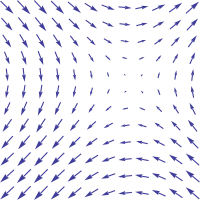Vector field

Imagine a big field, like a soccer or football field. Now let's pretend there is a giant wind blowing across the field, with different strengths and directions in different parts of the field. A vector field is like a map that shows us the direction and strength of this wind at every point on the field.
So, at one point on the field, the map might show us that the wind is blowing really strongly towards the left. At another point, the map might show us that the wind is blowing less strongly towards the right. And at yet another point on the field, the map might show us that the wind is blowing very weakly towards the north.
In math terms, a vector field describes a pattern of vectors (which have both a direction and a magnitude) that are assigned to each point in a particular space. It's kind of like having little arrows pointing in different directions and of different lengths, all over a field or a graph or some other area. The arrow at each point tells us the direction and amount of a certain quantity, like wind or electric or magnetic force, or even temperature or pressure.
So, in short, a vector field is a way to visualize and understand the patterns of a particular quantity that changes over space.
So, at one point on the field, the map might show us that the wind is blowing really strongly towards the left. At another point, the map might show us that the wind is blowing less strongly towards the right. And at yet another point on the field, the map might show us that the wind is blowing very weakly towards the north.
In math terms, a vector field describes a pattern of vectors (which have both a direction and a magnitude) that are assigned to each point in a particular space. It's kind of like having little arrows pointing in different directions and of different lengths, all over a field or a graph or some other area. The arrow at each point tells us the direction and amount of a certain quantity, like wind or electric or magnetic force, or even temperature or pressure.
So, in short, a vector field is a way to visualize and understand the patterns of a particular quantity that changes over space.
Related topics others have asked about:
